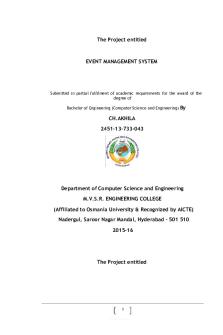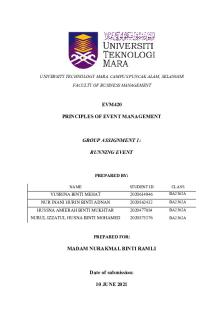Discrepant Event - Marshmallow PDF

| Title | Discrepant Event - Marshmallow |
|---|---|
| Course | Teaching Science to Middle Level Learners |
| Institution | University of Akron |
| Pages | 2 |
| File Size | 88.6 KB |
| File Type | |
| Total Downloads | 46 |
| Total Views | 126 |
Summary
Discrepant Event Activity Sheet...
Description
Discrepant Event: Marshmallow The science concepts that primary students need to know for this experiment are: that solids, liquids and gases have observable properties and behave in different ways (specifically that air has mass and takes up space) and that different materials have different properties
Misconceptions
1.
Air is not matter – Contributing to this misconception are the properties associated with air – invisibility, odourlessness, temperature, and flow or movement (Skamp, 2012, p.313; VDET, 2014a). Research findings do differ on students’ understanding of whether air is a gas, although some research has indicated that students up to the age of 12 years old generally see gases as combustible and therefore dangerous, unlike air (Skamp, 2012, p.313). 2. Air is weightless, does not take up space and cannot be captured – Tying into this belief that air is not matter is a commonly held belief (especially among younger students), that an empty container does not contain air (Skamp, 2012, p.313). In one study, only 22% of children aged 5-7 years old could identify that a container was filled with air (Krnel et al., 1998, p.268). Language use also plays a role here, as we tend to say idiomatically that a jar or container that has nothing in it is ‘empty’. This can cause confusion as children are “expected to grasp that although empty, they really contain air” (VDET, 2014a). For children who do understand that air takes up space, they will often still make a distinction between the air inside a container, and the air outside it (Krnel et al, 1998, p.269). As Krnel et al states “a frequent explanation is that air is one big bulk”, with one study revealing that 46% of children considered air to be a continuum (1998, p.269). Similarly, there appear to be some misconceptions regarding the weight of air, with many students believing it to be weightless (Driver in Krnel et al., 1998, p.269). 3. The movement of air is similar to water – Some studies have revealed that children also often hold misconceptions about the movement of air. For example, in one study, 11- to 12-year old children thought that when gas was forced into a container, more air was found on the bottom (Lee in Krnel et al., 1998, p.269). This reveals their belief that air is not equally distributed and flows in a similar way to water.
Student Explanations
You are pumping the marshmallows up The container is special (it’s magic) Marshmallows multiply when air is taken away Some air gets stuck and blows them up like balloons
When you take away the pressure from the air, marshmallows grow to their full size The air travelled through the marshmallows and puffed them up Air can change and grow bigger Letting the air back in squashes them from the outside. Questioning Sequence
1.
Who can tell me what is in the container? – Pass around container, students can shake and have a look 2. What do you think will happen when you remove the air from inside the container? 3. Describe what happened. Why do you think this happened? 4. Did anyone think the marshmallows would do something different? 5. What is happening each time I pump? 6. If air is being sucked out of the container, why do the marshmallows grow bigger? 7. What does the experiment tell us about the air in the marshmallows and container then? 8. What was happening when the marshmallows shrank back? Why? 9. What if we did the same experiment but with no marshmallows – is air still being sucked out of the container? 10. What if I put a gold coin in the container? What do you think will happen when I remove the air from inside the container? (Perform the experiment) 11. Describe what happened. Why do you think this is? 12. What does this mean about the different materials? Why do marshmallows increase in size and not the gold coins? 13. Draw a diagram illustrating what is happening to the marshmallows and air as the marshmallows expand, and also when the air is let back in. Explain how this is different or the same to your original explanation.
Procedure Place a mini marshmallow inside of a 7 oz. (200 ml) plastic syringe. Pull the plunger out so that the marshmallow has enough space to move freely. Plug the tip of the syringe with a cap or small piece of clay. Depress the plunger; the marshmallow will decrease in size even though the plunger is not touching it. Extract the plunger and the marshmallow will grow because there is less pressure on it allowing more air to fill the puffy sweet....
Similar Free PDFs

Discrepant Event - Marshmallow
- 2 Pages

Event
- 4 Pages

JOB DESRIPTION KEPANITIAAN EVENT
- 5 Pages

Event Management System
- 79 Pages

Event Management mcq
- 37 Pages

BREAK EVENT POINT
- 49 Pages

Strategic Event Planning Process
- 14 Pages

Event Setter Sdn Bhd
- 2 Pages

Signature Event Context
- 1 Pages

Special Event 1
- 2 Pages

Formularium Event Productie
- 2 Pages

BBA 602 Event-Management
- 35 Pages

Contoh Proposal Event
- 19 Pages

Mini Project-Event management
- 46 Pages
Popular Institutions
- Tinajero National High School - Annex
- Politeknik Caltex Riau
- Yokohama City University
- SGT University
- University of Al-Qadisiyah
- Divine Word College of Vigan
- Techniek College Rotterdam
- Universidade de Santiago
- Universiti Teknologi MARA Cawangan Johor Kampus Pasir Gudang
- Poltekkes Kemenkes Yogyakarta
- Baguio City National High School
- Colegio san marcos
- preparatoria uno
- Centro de Bachillerato Tecnológico Industrial y de Servicios No. 107
- Dalian Maritime University
- Quang Trung Secondary School
- Colegio Tecnológico en Informática
- Corporación Regional de Educación Superior
- Grupo CEDVA
- Dar Al Uloom University
- Centro de Estudios Preuniversitarios de la Universidad Nacional de Ingeniería
- 上智大学
- Aakash International School, Nuna Majara
- San Felipe Neri Catholic School
- Kang Chiao International School - New Taipei City
- Misamis Occidental National High School
- Institución Educativa Escuela Normal Juan Ladrilleros
- Kolehiyo ng Pantukan
- Batanes State College
- Instituto Continental
- Sekolah Menengah Kejuruan Kesehatan Kaltara (Tarakan)
- Colegio de La Inmaculada Concepcion - Cebu

